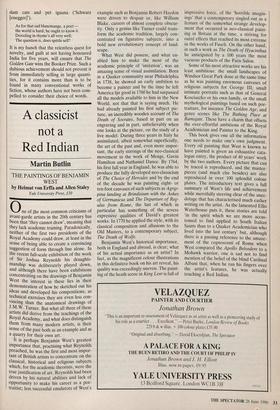A classicist not a Red Indian
Martin Butlin
THE PAINTINGS OF BENJAMIN WEST by Helmut von Erffa and Allen Staley
Yale University Press, £50
0 ne of the most common criticisms of avant-garde artists in the 20th century has been that 'they cannot draw', meaning that they lack academic training. Paradoxically, neither of the first two presidents of the Royal Academy could draw, at least in the sense of being able to create a convincing suggestion of form through line alone. In the recent full-scale exhibition of the work of Sir Joshua Reynolds his draughts- manship was deliberately played down, and although there have been exhibitions concentrating on the drawings of Benjamin West the interest in these lies in their demonstration of how he sketched out his ideas and developed his compositions; as technical exercises they are even less con- vincing than the anatomical drawings of J.M.W. Turner. But what all three of these artists did derive from the teachings of the Royal Academy, and what does distinguish them from many modern artists, is their sense of the past both as an example and as a quarry for their own art.
It is perhaps Benjamin West's greatest importance that, practising what Reynolds preached, he was the first and most impor- tant of British artists to concentrate on the classical, historical and religious subjects which, for the academic theorists, were the true justification of art. Reynolds had been driven by his natural abilities and lack of opportunity to make his career as a por- traitist; less successful emulators of West's example such as Benjamin Robert Haydon were driven to despair or, like William Blake, careers of almost complete obscur- ity. Only a genius like Turner could trans- form the academic tradition, largely con- centrated on figurative subjects, into a bold new revolutionary concept of land- scape.
What West did possess, and what en- abled him to make the most of the academic principle of 'imitation', was an amazing sense of visual assimilation. Born in a Quaker community near Philadelphia in 1738, he showed an early ambition to become a painter and by the time he left America fir good in 1760 he had surpassed all the models available to him in the New World, not that that is saying much. He had already painted his first subject pic- ture, an incredibly wooden account of The Death of Socrates, based in part on an engraving and in part, unbelievably when one looks at the picture, on the study of a live model. During three years in Italy he assimilated, albeit somewhat superficially, the art of the past and, even more impor- tant, the early stirrings of the neo-classical movement in the work of Mengs, Gavin Hamilton and Nathaniel Dance. By 1764, his first full year in England, he was able to produce the fully developed neo-classicism of The Choice of Hercules and by the end of the decade he was painting eight- or ten-foot canvases of such subjects as Agrip- pina landing at Brindisium with the Ashes of Germanicus and The Departure of Reg- ulus from Rome, the last of which in particular has something of the severe expressive qualities of David's greatest works. In 1770 he applied the style, with its classical composition and allusions to the Old Masters, to a contemporary subject, The Death of Wolfe. Benjamin West's historical importance, both in England and abroad, is clear; what of his actual importance as an artist? In fact, as the magnificent colour illustrations in this definitive book on his art reveal, his quality was exceedingly uneven. The paint- ing of the heath scene in King Lear is full of impressive force, of the 'horrible imagin- ings' that a contemporary singled out as a feature of the somewhat strange develop- ment that occurred in neo-classical paint- ing in Britain at the time, a striving for outré effects that reached its most extreme in the works of Fuseli. On the other hand, in such a work as The Death of Hyacinthus he anticipated by a 100 years the most vacuous products of the Paris Salon.
Some of his most attractive works are his least ambitious: the small landscapes of Windsor Great Park done at the same time as he was painting enormous canvases of religious subjects for George III; small intimate portraits such as that of General Kosciuszko or his own family, or the small mythological paintings based on such por- traiture, for instance The Golden Age; and genre scenes like The Bathing Place at Ramsgate. These have a charm that offsets the over-effortful ambitions of the Royal Academician and Painter to the King. This book gives one all the information one needs to make one's own judgment. Every oil painting that West is known to have painted is given an exhaustive cata- logue entry, the product of 40 years' work by the two authors. Every picture that can be traced is .reproduced, and the master- pieces (and much else besides) are also reproduced in over 100 splendid colour plates. The introductory text gives a full summary of West's life and achievement while mercifully steering clear of the anec- dotage that has characterised much earlier writing on the artist. As the lamented Ellis Waterhouse puts it, these stories are told `in the spirit which we are more accus- tomed to find applied to South Italian Saints than to a Quaker Academician who lived into the last century' but, although there is a passing reference to the amaze- ment of the cognoscenti of Rome when West compared the Apollo Belvedere to a Mohawk warrior, one is sad not to find mention of the belief of the blind Cardinal Albani that, when he ran his fingers over the artist's features, he was actually touching a Red Indian.


















































 Previous page
Previous page